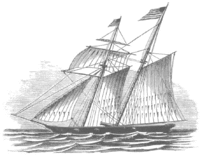
USS President was a wooden-hulled, three-masted heavy frigate of the United States Navy, nominally rated at 44 guns; she was launched in April 1800 from a shipyard in New York City. President was one of the original six frigates whose construction the Naval Act of 1794 had authorized, and she was the last to be completed. The name "President" was among ten names submitted to President George Washington by Secretary of War Timothy Pickering in March of 1795 for the frigates that were to be constructed. Joshua Humphreys designed these frigates to be the young Navy's capital ships, and so President and her sisters were larger and more heavily armed and built than standard frigates of the period. Forman Cheeseman, and later Christian Bergh were in charge of her construction. Her first duties with the newly formed United States Navy were to provide protection for American merchant shipping during the Quasi War with France and to engage in a punitive expedition against the Barbary pirates in the First Barbary War.
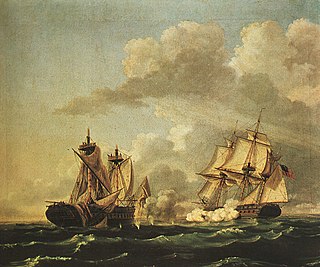
The capture of HMS Macedonian was a naval action fought near Madeira on 25 October 1812 between the heavy frigate USS United States, commanded by Stephen Decatur, and the frigate HMS Macedonian, under the command of John Surman Carden. The American vessel won the long bloody battle, capturing and bringing Macedonian back to the United States. It was the first British warship to ever be brought into an American harbor.
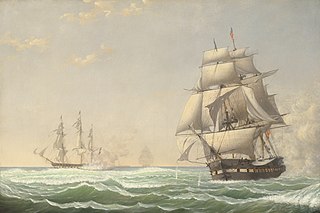
The capture of USS President was one of many naval actions fought at the end of the War of 1812. The frigate USS President tried to break out of New York Harbor but was intercepted by a British squadron of four warships and forced to surrender.
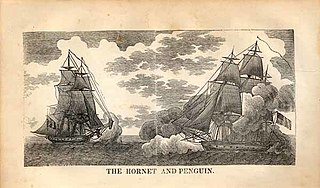
On 23 March 1815 USS Hornet captured HMS Penguin in a short battle off Tristan da Cunha. It was one of several engagements that took place after the War of 1812 had ended, and was the final action between British and American forces. The American gunnery was far more effective than the British, despite the two vessels being virtually identical in strength. After exchanges of broadsides and musket fire, the British commander was killed. The British brig rammed the American ship in an attempt to board, but the two were separated and Penguin was disabled shortly afterwards when the foremast fell, forcing the British to surrender. The British brig was too badly damaged to be salvaged and was set ablaze by the victors after its stores and surviving crew were removed.

HMS Endymion was a 40-gun fifth rate that served in the French Revolutionary Wars, the Napoleonic Wars, the War of 1812 and during the First Opium War. She was built to the lines of the French prize Pomone captured in 1794. Due to her exceptional handling and sailing properties, the Severn-class frigates were built to her lines, although the gunports were rearranged to mount an extra pair of guns per side, the ships were made of softwood and were not built until nearly the end of the Napoleonic Wars.

HMS St Lawrence was a 14-gun schooner of the Royal Navy. She had been built in 1808 in St. Michaels, Talbot County, Maryland for Thomas Tennant and sold to Philadelphians in 1810. During the War of 1812 she was the US privateer Atlas. The UK captured her in 1813 and renamed her St Lawrence. The US privateer Chasseur recaptured her in 1815, and then HMS Acasta re-recaptured her.

HMS Epervier was an 18-gun Cruizer-class brig-sloop of the Royal Navy, built by Ross at Rochester, England, and launched on 2 December 1812. USS Peacock captured her in 1814 and took her into service. USS Epervier disappeared in 1815 while carrying dispatches reporting the signing of a treaty with the Dey of Algiers.

Rhin was a 40-gun Virginie-class frigate of the French Navy launched in 1802. She was present at two major battles while in French service. The Royal Navy captured her in 1806. Thereafter Rhin served until 1815 capturing numerous vessels. After the end of the Napoleonic Wars she was laid up and then served as a hospital for many years. She was finally broken up in 1884.
HMS Landrail was a Cuckoo-class schooner built by Thomas Sutton at Ringmore, Teignmouth. Like all her class she carried four 12-pounder carronades and had a crew of 20. She had a relatively uneventful career during the Napoleonic Wars and the War of 1812 until 1814 when she was taken in a notable action, and then retaken. She was sold in approximately 1818.
HMS Ballahoo was the first of the Royal Navy's Ballahoo-class schooners, vessels of four 12-pounder carronades and a crew of 20. The prime contractor for the vessel was Goodrich & Co., in Bermuda, and she was launched in 1804. She patrolled primarily in the Leeward Islands, taking several small prizes, before an American privateer captured her in 1814 during the War of 1812.
HMS Shelburne was the American letter of marque schooner Racer, built in Baltimore in 1811 and captured by the British in 1813. She served on the American coast, capturing the American brig Frolic. She also captured some merchantmen and was sold in Britain in 1817.

The Battle of Rappahannock River was fought in 1813 during the War of 1812. A British force blockading the Rappahannock River of Virginia sent several hundred men in boats to attack four American privateers. Ultimately the British were victorious and the American ships were captured.
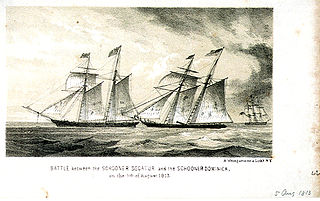
Decatur was an American schooner built in Charleston, South Carolina, in 1813 for privateering during the Atlantic Ocean theater of the War of 1812. She was named for the United States Navy Commodore Stephen Decatur, who served with distinction in many of America's earliest conflicts. She was the largest privateer out of Charleston. The Royal Navy captured Decatur in 1814.

The Battle of Barbados was fought in March 1778 during the American Revolutionary War. While escorting a fleet of American ships in the West Indies, the frigate USS Randolph was attacked by the British ship-of-the-line HMS Yarmouth. The following action resulted in America's most costly naval defeat, in terms of human lives, until the sinking of USS Arizona in 1941.

The Capture of HMS Savage was a naval battle of the American Revolutionary War involving the American privateer Congress and the British sloop-of-war HMS Savage. It occurred in September 1781 off South Carolina and is considered one of the hardest-fought single ship actions of the war.
HMS Dominica was the French privateer schooner J(T?)opo L'Oeil that the British captured in 1807 in the Leeward Islands. She took part in one inconclusive single-ship action before she foundered in 1809.

HMS Dominica was the French letter of marque schooner Duc de Wagram, which the British captured in 1809 in the Leeward Islands and took into the Royal Navy in 1810. The American privateer Decatur captured her in 1813 in a notable single-ship action. However, Majestic recaptured her in 1814. She was wrecked in 1815
HMS Alphea was built of Bermudan pencil cedar as a cutter and launched in 1804. Later she was converted to a schooner. She captured a number of small prizes before September 1813 when she blew up in a single-ship action with the loss of her entire crew.
HMS Decouverte was the French schooner Eclipse, launched in 1804, that was captured in 1806. The Royal Navy took her into service as HMS Decouverte. She served in the Caribbean, where she captured two privateers, one French and one American. She was sold in 1816.

Comet, an American schooner, was built in 1810 at Baltimore, Maryland. She was owned by "a group of wealthy Baltimore investors." Under Captain Thomas Boyle, who was a part owner of the schooner, Comet sailed from July 1812 to March 1814 as a privateer, which was a type of ships licensed by the United States during the War of 1812 to harass the British merchant vessels and divest their cargoes.

